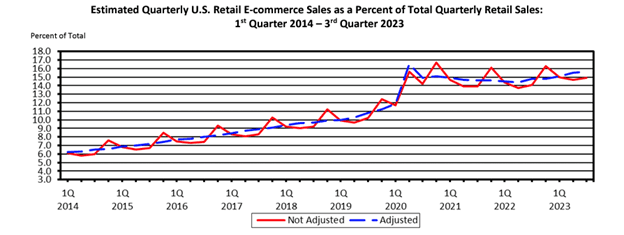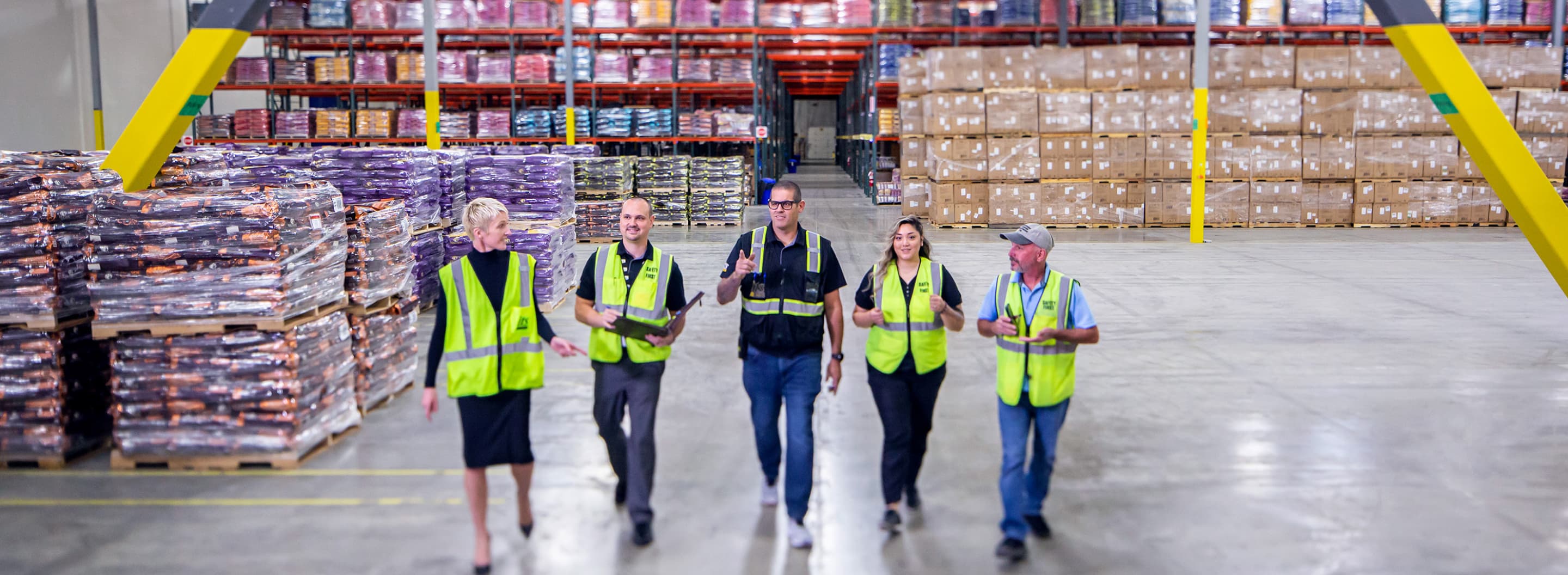What to Consider When Expanding a Fulfillment and Logistics Network

Customer expectations have grown alongside demand over the years, especially when it comes to ecommerce supply chain. The Census Bureau of the Department of Commerce reported United States retail ecommerce sales increased by 2.3% in Q3 from Q2 in 2023 and increased 7.8% from Q3 2022. As can be seen in the chart below, the pandemic era boom of ecommerce has had a lasting effect on the supply chain.
As demand increases, businesses face pressure to redesign their fulfillment networks to offer what customers are looking for: faster delivery, free (or less expensive) shipping, online ordering, curbside pickup, a painless return process and more. For those in the process of expanding a fulfillment and logistics network, these are a few things to consider.

Weigh all options for fulfillment network expansion
There are a lot of different expansion options to choose from, so before committing to a decision, make sure to understand all options for warehousing solutions. Common options for this include purchasing or leasing assets and warehouse space, hiring a third-party logistics (3PL) company, or using on-demand retail and fulfillment services. The correct choice depends entirely on the business model, product demand, growth plans and volume. For generally predictable demand and enough volume, owning fulfillment centers might be a good option. High utilization of these facilities reduces the risks of fixed investments and gives total visibility and control over inventory management and the logistics process. However, if there are high levels of seasonality or extreme peaks and valleys in volume, then these fixed investments can quickly become unproductive, inefficient, and costly. A flexible fulfillment option like on-demand warehousing for unpredictable demand may be the best choice. When lacking the capabilities internally to handle fulfillment and logistics, experiencing drastic changes in volume, or needing additional expertise and services lines, outsourcing fulfillment and distribution needs to a full-service 3PL might be the perfect option. For many companies, especially larger ones, a mix of all these options and having a robust fulfillment network is often the best solution to ensure all needs can be accommodated.
Understand how to meet growing customer expectations
Providing excellent customer service and experience can be key to success, and it’s become increasingly difficult and costly to meet these high expectations. It’s essentially mandatory to offer fast and free omnichannel fulfillment options. When expanding a logistics network, make sure to keep customers’ most important wants and needs in mind. Is there a physical store that can offer buy online, pick-up-in-store (BOPIS) fulfillment for their convenience? What about free two-day shipping? Free returns? What needs to be done to offer these options to customers? When considering a fulfillment network expansion, prioritize the needs of customers and make sure the size of the network of fulfillment centers matches demand. It’s also important to remember that maybe not every product sold needs to be available for fast and free shipping. For example, it might make sense to only offer that for the best-selling products and put those products closer to end customers through smaller fulfillment nodes in high demand areas to fulfill those orders faster. Analyzing product demand by volume and frequency and implementing strategies like this will help keep customers happy, and business running smoothly and cost effective.
Choose the right time to scale
The proper timing of a logistics network expansion is key, largely because long lead times are required in setting up new nodes, facilities, or even large-scale distribution centers, especially when leasing space or working with a third-party logistics partner. Generally, after Q4 is a good time to look at the data from any peak season or holiday spikes in demand and analyze the results to reveal potential growth opportunities. The explosive expansion of ecommerce has illustrated that it’s impossible to be prepared for everything, which highlights the importance of building flexibility and resiliency into a supply chain and logistics network design. Make sure to look at historical data and develop an extensive plan that will allow scaling while continuing to prioritize customers’ needs.
Consider the best areas for geographic expansion
Because getting products to customers in a timely manner is more important than ever, it’s crucial to position distribution centers in strategic locations that will reach as many people as possible within two days. This can be done in a variety of ways depending on the amount of distribution nodes needed. For example, ITS Logistics has three distribution centers near Indianapolis, IN, three in Reno/Sparks, NV, and one in Dallas/Ft. Worth, TX—reaching over 95 percent of the US population within two days ground. When designing a logistics network, consider the geographic infrastructure including proximity to interstates, ports, air hubs and rail yards that will reach more people quickly. Also be sure to investigate any financial incentives states offer that make for a business-friendly climate. Finding a third-party logistics company with operations in locations that match business needs can help accomplish this, too. Researching intently and determining the ideal locations for distribution centers will offer faster delivery times, improve service to customers and ultimately grow business.
Supply chain services to expand fulfillment and logistics networks
Expanding your fulfillment and logistics network to place inventory closer to customers through new fulfillment nodes, add ship-from-store capabilities, or implement a full omnichannel distribution solution is no small feat. However, having a thorough plan to expand a network is key because it can offer an effective way to get products to customers more quickly and affordably. When considering the best way to do this, remember to weigh the full range of warehousing and fulfillment options, evaluate, and understand delivery time to cost ratio, and ensure the timing is right. When looking to hire a 3PL in North America to help with this undertaking, or if there are simply questions about the best way to expand a fulfillment network, ITS Logistics can help.



